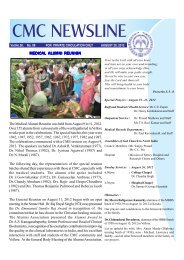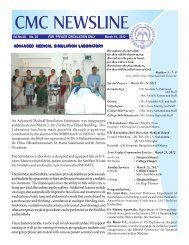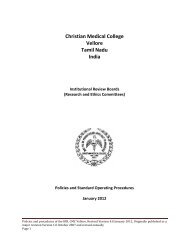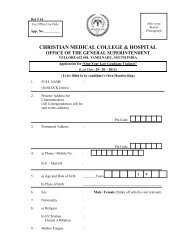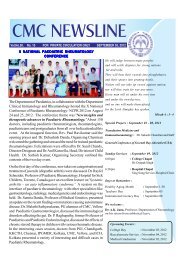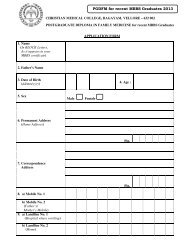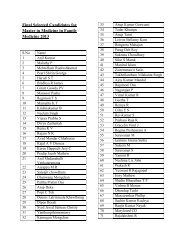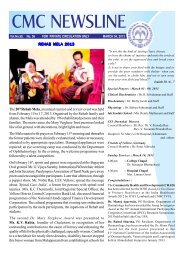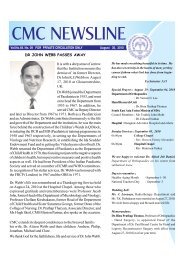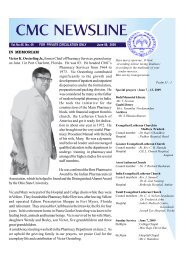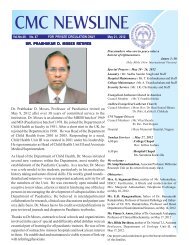Jacob Chandy - Christian Medical College
Jacob Chandy - Christian Medical College
Jacob Chandy - Christian Medical College
- No tags were found...
Create successful ePaper yourself
Turn your PDF publications into a flip-book with our unique Google optimized e-Paper software.
JACOB CHANDYresidency position in neurosurgery there. Rhoads, in 2 letters toDr Penfield, had high praise for the young <strong>Chandy</strong>: “Dr <strong>Chandy</strong>has spent the past year taking the course in Surgery offered by theGraduate School of Medicine of the University of Pennsylvania.He is agreeable and acceptable on a personal basis. I believe hehas a good mind and he is a man who will carry through a longperiod of training. I think he is a first class person.” He wroteagain on August 14, 1945, “I like <strong>Jacob</strong> <strong>Chandy</strong> even better thanI did before—I think he has a really fine mind and character andwill carry high standards of thought and practice to an area wherethere is very real need.” With these recommendations, MNI admittedhim and he became one of the international jewels in theircrown. <strong>Chandy</strong> joined MNI as a neurosurgical resident in October1945 with a stipend of $20 per month.He worked with Francis McNaughton in clinical neurologyand neuroanatomy for 6 months and was then posted with WilliamCone for 1 year. He adopted Cone’s work ethic and in later yearsinsisted on similar work habits from his residents in Vellore. Oneof these “standing instructions” was that every patient must receivea workup with treatment initiated within half an hour of admissionto the ward irrespective of when the patient was admitted.<strong>Chandy</strong> learned most of his neurosurgery and neuropathologyfrom Cone. <strong>Chandy</strong> passed the fellowship written examinationof the Canadian Royal <strong>College</strong> of Surgeons held in Montreal andthe clinical and oral examinations held in Toronto in late 1947. Hewas working as Chief Resident with Cone when Wilder Penfieldsuggested that <strong>Chandy</strong> move to the University of Chicago whereTheodore Rasmussen was taking over as a professor of neurosurgery.He worked with Rasmussen in Chicago for a year beforefinally returning to India in 1949. He was awarded the Fellowshipof the American <strong>College</strong> of Surgeons and the International <strong>College</strong>of Surgeons before he left the United States. Rasmussen wrote:My acquaintance with <strong>Jacob</strong> <strong>Chandy</strong> dates back tohis 2 years at MNI in ’46 and ’47. I was pleasedwhen he accepted my invitation to join me at theUniversity of Chicago in ’48, when I took charge ofthe Department of Neurosurgery succeeding Dr EarlWalker after his departure to Johns HopkinsUniversity. <strong>Chandy</strong>’s ability, energy, and clinicalacumen were of great help to me in thereorganization of the department, and it was a busyand interesting year for both of us.<strong>Chandy</strong>’s training in North America was to influence his work,attitude toward the training of doctors, and patient care for the restof his life. He writes “they were the years which laid the foundationof my life and career.” 6 He not only acquired training in neurosurgerybut also in research methodology. He was exposed tothe residency system of training medical postgraduates. Duringhis time in North America, he also became acquainted with severalpeople who helped him later when he was in Vellore. Onesuch individual was Sir Lakshmanaswami Mudaliar, a past professorof obstetrics and gynecology at MMC and Vice Chancellorof Madras University (to which CMC was affiliated). He had been<strong>Chandy</strong>’s teacher at MMC and met <strong>Chandy</strong> when he visited theUniversity of Chicago in 1948. Their friendship stood <strong>Chandy</strong>in good stead on several occasions in later years, especially when<strong>Chandy</strong> proposed the creation of training programs in several specialtiesin Vellore, notably neurosurgery and neurology. This wasalso a period of great historical significance and changes in India,with its achievement of independence from Britain in 1947.FIRST INDIAN DEPARTMENT OFNEUROLOGICAL SCIENCESIn 1948, Dr Cochrane, Director of CMC Vellore and one ofthe foremost experts in leprosy at the time, invited <strong>Chandy</strong> tostart a department of neurosurgery at CMC Vellore. But the invitationcame with the caveat that CMC had no funds to acquire thenecessary equipment. Once again, <strong>Chandy</strong> turned to Harrisonfor help. Harrison managed to obtain 2 donations totaling $13,000and <strong>Chandy</strong> was on his way. Although <strong>Chandy</strong> was appointed tothe CMC faculty in January 1949, he could only join on April14, 1949, after completing the purchase of the necessary equipmentin the United States. This was the beginning of his long andinitially lonely journey to establish neurology and neurosurgery asspecialties in India.CMC VELLOREIn 1900, Dr Ida Sophia Scudder (Figure 2) founded what subsequentlybecame the CMC and Hospital (CMCH) to serve the poorrural community of Vellore in south India, a few dusty hours by roadfrom Madras (Chennai). Dr Scudder was born in India where herfather Dr John Scudder was working as a medical missionary andFIGURE 2. Ida Sophia Scudder, founder of <strong>Christian</strong><strong>Medical</strong> <strong>College</strong> Vellore. Circa 1902.NE UROSURGERY VOLUME 67 | NUMBER 3 | SEPTEMBER 2010 | 569
ABRAHAM ET ALa pastor of the Reformed Church of America. She was sent to theUnited States for her education and was one of the earliest womenmedical graduates of Cornell University in Ithaca, New York.CMCH began as a 1-room dispensary in her father’s bungalow inVellore. In 1924, a 267-bed hospital was built on the present site.In 1942, Madras University recognized the CMCH for trainingleading to the MBBS degree. In 1947, coincident with India’s independence,the first group of men was admitted to what was intil thena women’s medical college, and the name CMCH was adopted.At present, CMCH is a tertiary care teaching facility that is recognizedas one of the premier referral centers in India.However, when <strong>Chandy</strong> first arrived in Vellore in 1949, hefound a hospital that was struggling with the running of evenbasic general surgery (Figure 3). He was requested to contributeto the care of patients with general surgical diseases, especiallyas his colleagues in medicine and general surgery were convincedthat there were very few patients with neurosurgical diseases inIndia and that he would not have much to do. But he was resolutethat such as step on his part would not only delay but alsoprobably defeat his efforts at starting the specialties of neurosurgeryand neurology. <strong>Chandy</strong> describes how he got to operateon his first patient. 7 After obtaining permission from theprofessor of medicine to visit the medical wards, he asked theward sister (head nurse) to show him any patient admitted witha severe headache. A male patient admitted with severe headacheand vomiting was identified. He had been diagnosed as havingmeningovascular syphilis and was being treated for that. <strong>Chandy</strong>examined his fundus and found florid papilledema. With thehelp of other clinical signs, he diagnosed a right frontal lobemass. He went on to perform an air ventriculogram, which confirmedhis clinical diagnosis, and he operated on the patient,achieving a successful outcome. He thus convinced his skepticalcolleagues that neurosurgical problems did exist in India andsoon thereafter his colleagues in general surgery, internal medicine,obstetrics/gynecology, and pediatrics lent him the use ofa few beds in their wards for his inpatients. A neurology outpatientclinic was held 2 afternoons per week. A woman physician,Dr P. Isaiah, volunteered to be <strong>Chandy</strong>’s full-time assistant. Shewas a gifted surgeon, worked hard, and was a great help in settingup the department.Within a year, a UK-trained physician, Dr Baldev Singh, whowas from the State of Punjab in north India and was interestedin neurology, visited Vellore and decided to throw in his lot with<strong>Chandy</strong>. Singh is considered to be the father of neurology inIndia. He ended his lucrative practice in Amritsar, went to trainin electroencephalography with Dr Gibbs in Chicago, and returnedto Vellore. An electroencephalography laboratory was started in1952. K.K. George, under the tutelage of Singh, was not onlyable to record electroencephalograms, but also to maintain theGrass instrument. The first Grass electroencephalography unit,acquired in 1952, continued to work until the 1990s, much to thepride and joy of the manufacturers. Later, an electroencephalographytraining program was started with George as the instructor;the training of skilled technicians for neurological centerswas on its way. In 1954, a separate neurology and neurosurgeryward for men came into being (Figure 4). At the request of<strong>Chandy</strong>’s benefactor and mentor Harrison, the Irwin YoungFoundation in the United States provided the funds for this ward.Another floor for women and children was added in 1963 anddeclared open by the then Health Minister of India, Dr SushilaNayyar (Figure 5). With 2 other small extensions, the capacityof the ward had increased to 120.FIGURE 3. Aerial view of <strong>Christian</strong> <strong>Medical</strong> <strong>College</strong> Hospital at around thetime <strong>Jacob</strong> <strong>Chandy</strong> arrived there in 1949.FIGURE 4. Inauguration of a separate ward for male neurosurgical and neurologicalpatients in February 1954 by Rajkumari Amrit Kaur, then UnionMinister of Health.570 | VOLUME 67 | NUMBER 3 | SEPTEMBER 2010 www.neurosurgery-online.com
JACOB CHANDYJubilee Commemorative Volume of the Department of NeurologicalSciences, CMC, Vellore): “<strong>Chandy</strong> has been a real leader inNeurosurgery and education in India. He is a good friend and Ihave deep affection for him. He is an excellent clinician and hasa searching mind when it comes to basic sciences.” Dr and MrsPenfield also attended the annual meeting of the NeurologicalSociety of India held in Agra in December 1957.EARNING THE TRUST OF PATIENTSAND COLLEAGUESFIGURE 5. <strong>Chandy</strong> with Dr Sushila Nayar (seated third from left), thenUnion Minister of Health, at the inauguration of the Neurology Wards inCMC Vellore, 1963. Also seen in the picture is <strong>Jacob</strong> Abraham, the secondMS (Neurosurgery) in India (standing, second from left).FIGURE 6. Wilder Penfield laying the cornerstone for the Department ofNeurological Sciences block in CMC Vellore on February 23, 1957.Eight years into the growth of neurosciences, Wilder Penfieldlaid the foundation of the new neurology block on February 23,1957 (Figure 6). Penfield wanted to visit his one-time trainee’ssetup and see for himself all the wonderful things that he hadheard about <strong>Chandy</strong>’s endeavors. Dr and Mrs Penfield spent acouple of weeks in Vellore. His teaching sessions and his immensehumanity and wisdom inspired staff and students alike. Those ofus who had the privilege of being present at these sessions and gotto know him will never forget the encounter. In our minds, weconsidered him the “grandfather neuron.” Dr Penfield summedup his impressions of <strong>Chandy</strong> (as found in an article in the GoldenA team approach was the underlying philosophy of the department.The accepted focus around which the department revolvedwas the patient is the most important person. Whoever was onthe scene, boss, assistant, nurse, or intern, did the job required,whether it was transferring a patient from the trolley to the bed,giving him a cold sponge, or inserting a Ryle’s feeding tube. Atthe time, we scarcely realized the tremendous goodwill and gratitudethat such ordinary deeds generated in the patient’s relatives.The one person who inspired full confidence in all the patientsby her empathy and knowledge was Sister Elizabeth, the departmentalsister. After establishing an efficient nursing unit, she wassent to hone her skills at MNI for a year.Surgery for epilepsy was started in the 1950s with Singh andGeorge at the controls. In the latter part of the 1950s, a largenumber of cases of cortical ablations, anterior temporal lobectomies,and even some hemispherectomies were being done forpatients whose epilepsy was difficult to control with medication.In the 1950s and 1960s, <strong>Chandy</strong> undertook the neurosurgicalmanagement of various clinical conditions for which there werefew, if any, medical options. Following the biweekly neurologyoutpatient clinic, 6 to 8 psychiatric patients were treated withelectroconvulsive therapy under the supervision of Singh or <strong>Chandy</strong>.Patients who failed to respond were admitted to the ward toundergo a modified Freeman and Watts prefrontal lobotomy.The management of end-stage cancer pain was another seriouscondition that <strong>Chandy</strong> had to deal with. There were a number ofpatients in this region with cancer of the cheek involving the jawand cervical lymph nodes. If the life expectancy was 2 to 3 months,a prefrontal lobotomy was done. A trigeminal rhizotomy wasresorted to if the life expectancy was longer. For patients withinfiltrating cancer of the cervix, a high dorsal spinothalamic tractotomywas done. Hypophysectomies were done for infiltratingbreast cancer with bony metastases. Patients with essential hypertensionresistant to drug therapy were referred for a modifiedSmithwick dorsal sympathectomy. Another group of patients withlower limb ischemia underwent bilateral lumbar sympathectomy.<strong>Chandy</strong>, by this time, had started to become recognized throughoutSouth Asia as a pioneer in both neurosurgery and neurology,and several dignitaries sought his consultation. These included thefirst President of India, Dr Rajendra Prasad (Figure 7) and IndiraGandhi, who subsequently became India’s Prime Minister (Figure8). <strong>Chandy</strong> describes the case of the Prime Minister of Ceylon (SriLanka) whom he was called to see in the early 1950s. 8 The PrimeNE UROSURGERY VOLUME 67 | NUMBER 3 | SEPTEMBER 2010 | 571
ABRAHAM ET ALFIGURE 7. <strong>Chandy</strong> (second from left) with Dr Rajendra Prasad (in middle),then President of India, on his visit to CMC Vellore in 1960. Dr IdaB. Scudder (a radiologist and niece of the founder of CMC Ida S. Scudder),Director, CMC Vellore is to Dr Prasad’s left.FIGURE 9. Early neurosurgical trainees with Dr Penfield during his visitto the Department in 1957. Sitting: Penfield (second from left), <strong>Chandy</strong>(third from left) and Charles E. Klontz (a visiting neurologist from the UnitedStates, second from right). Standing (from left to right): Irvin Samuel, K.V.Mathai, Gajendra Sinh, S.R. Dharker, and R.N. Roy (the last 4 were <strong>Chandy</strong>’sfirst 4 residents).FIGURE 8. <strong>Chandy</strong> with Mrs Indira Gandhi (who later went on to becomeIndia’s Prime Minister) during a visit to CMC Hospital in 1958.Minister was in a coma of undetermined etiology. On walking intothe patient’s room, <strong>Chandy</strong> got the acidotic smell of diabetic comaand confirmed the diagnosis of diabetic ketoacidosis with urineanalysis. The appropriate treatment was promptly initiated, butunfortunately it was too late to save the Prime Minister.TRAINING IN NEUROSURGERYAND NEUROLOGYIn 1955, 6 years after the department started, R.N. Roy fromCalcutta was admitted as the first neurosurgical trainee. He wasfollowed a year later by Gajendra Sinh from Bombay and 6 monthslater by R.S. Dharker from Gwalior. All 3 had finished their trainingin general surgery (Figure 9). They spent at least 2 years inneurosurgery before returning to set up a department of neurosurgeryin their respective states. In 1957, in the eighth year of the department’sexistence, Madras University approved CMC Vellore fora higher specialty training course leading to a Master of Surgerydegree in neurosurgery. K.V. Mathai, a medical graduate of CMCVellore, was the first candidate to be enrolled. This was the first university-recognizedneurosurgery training program in the country.It was also the first higher specialty training program in India(until then, formal degrees were awarded only in basic specialtiessuch as general surgery and orthopedics). In 1958, he also initiatedthe first formal training program in neurology and encouragedother specialties such as cardiothoracic surgery and cardiologyand urology to start formal training programs at CMC.<strong>Chandy</strong> had a deep resonant voice, but was not by any standardsa gifted speaker. However, he was direct, decisive, and outspoken,making him a favorite featured character in student skitsand legends. Nevertheless, he had a remarkable degree of patienceas a teacher and would stand through detailed case presentationsday after day.When the student or resident had finished and was hoping foraffirmation, there would be a moment of silence, broken by agruff “You are crazy!”In an era of very limited radiographic capabilities, <strong>Chandy</strong> wasunmatched as a clinical diagnostician. His calmness and gentlehandling of the tissues and the precision and easy flow of his operatingtechnique were a joy to watch. In his “theater vocabulary,”572 | VOLUME 67 | NUMBER 3 | SEPTEMBER 2010 www.neurosurgery-online.com
JACOB CHANDYthe word routine did not exist. The watchers would also havenoticed a period of silent prayer, with knife in hand, before hecommenced any operation. The reaction of one of the traineeswas “If he requires God’s help, what about the rest of us?”J. C. <strong>Jacob</strong>, one of the early neurologists to work in the departmentreminisces (personal communication):One of the mental images I have is that of thephotographs that lined Dr <strong>Chandy</strong>’s office—theyincluded his father, Rev M. J. <strong>Chandy</strong>, and hismentors, Drs Paul Harrison, Jonathan Rhoads,Wilder Penfield, and Theodore Rasmussen. His sterndiscipline, commitment to excellence and service, anduncompromising adherence to principles were someof the sterling qualities that he inherited or acquiredfrom these individuals.By the time <strong>Chandy</strong> retired in 1970, he had trained nearly 25neurosurgeons and neurologists, several of whom went on to createdepartments of neurosurgery and neurology all over India, inlittle pockets of excellence (Table). His early neurosurgical trainees,K.V. Mathai and <strong>Jacob</strong> Abraham, followed in <strong>Chandy</strong>’s footstepsand took on the leadership of the Department of NeurologicalSciences after <strong>Chandy</strong>’s retirement. <strong>Chandy</strong> also influenced severalgenerations of medical students including one of the authorsof this article (R.K.N.), who entered medical school at CMC in1969, during the time when <strong>Chandy</strong> was the Principal.RESEARCH IN THE DEPARTMENTIn 1958, Dr B.K. Bachhawat joined the team and started thefirst neurochemistry laboratory in India, in a corner of the basementof the neurology block, having as his only furniture an oldbench and a discarded library table. From these humble beginnings,he developed one of the finest neurochemistry laboratoriesin the world at the time. The clamor for training inneuro chemistry forced 3 or 4 universities in India to recognizethe training in Vellore as qualification for their PhD degrees.The team of <strong>Chandy</strong>, Singh, and Bachhawat (neurosurgery, neurology,and neurochemistry) combined the best of clinical andbasic sciences in their pursuit of excellence in a mystery-shroudedspecialty, which was either ignored or avoided by most Indian studentsof medicine at that time. <strong>Chandy</strong>’s dream of a unifieddepartment of neurological sciences (similar to that at MNI)that excelled in clinical work and research was thus established.Neuropathology and neurophysiology were added later. Thecombined Department of Neurological Sciences continues atCMC to this day.Under normal circumstances for a clinical team inundated withpatients, research is given the lowest priority. But for <strong>Chandy</strong>,research constituted an integral part of a robust clinical team. Thismindset most probably resulted from his exposure to research indifferent institutions in North America. The purpose of his earlypublications was to educate medical practitioners in India in com-TABLE. List of Dr. <strong>Jacob</strong> <strong>Chandy</strong>’s Neurosurgical Trainees and Their Careers aNameYears ofTraining at CMCAcademic Career in NeurosurgeryR.N. Roy 1955-1957 Professor of Neurosurgery, Bangur Institute of Neurology, CalcuttaGajendra Sinh 1956-1957 Professor of Neurosurgery, Grant <strong>Medical</strong> <strong>College</strong>, BombayR.S. Dharker 1956-1958 Professor of Neurosurgery, GR <strong>Medical</strong> <strong>College</strong>, Gwalior, Madhya PradeshK.V. Mathai 1958-1961 Professor of Neurosurgery, CMC Vellore<strong>Jacob</strong> Abraham 1960-1962 Professor of Neurosurgery, CMC VelloreK.N. Namboodripad 1960-1963 Professor of Neurosurgery, CMC Ludhiana, PunjabK.V. Chalapati Rao 1961-1963 Professor of Neurosurgery, Andhra <strong>Medical</strong> <strong>College</strong>, Vishakhapatnam, Andhra PradeshU.S. Vengsarkar 1961-1964 Hon. Professor of Neurosurgery, TNM <strong>Medical</strong> <strong>College</strong>, Bombay, MaharashtraA.K. Banerji 1962-1964 Professor of Neurosurgery, All-India Institute of <strong>Medical</strong> Sciences, New DelhiGoodwin Newton 1962-1965 Professor of Neurosurgery, KG <strong>Medical</strong> <strong>College</strong>, Lucknow, Uttar PradeshSanatan Rath 1963-1965 Professor of Neurosurgery, SCB <strong>Medical</strong> <strong>College</strong>, Cuttack, OrissaM. Sambasivan 1964-1966 Professor of Neurosurgery, Trivandrum <strong>Medical</strong> <strong>College</strong>, Trivandrum, KeralaP. Narendran 1965-1966 Professor of Neurosurgery, Madras <strong>Medical</strong> <strong>College</strong>, Madras, Tamil NaduRamesh Chandra 1965-1967 Professor of Neurosurgery, Patna <strong>Medical</strong> <strong>College</strong>, Patna, BiharK.V. Devadiga 1966-1968 Professor of Neurosurgery, Kasturba <strong>Medical</strong> <strong>College</strong>, Mangalore, KarnatakaI. Dinakar 1966-1968 Professor of Neurosurgery, Nizam’s Institute of <strong>Medical</strong> Sciences, Hyderabad, Andhra PradeshK.M. John 1967-1969 Private practiceN.D. Vaishya 1968-1970 Professor of Neurosurgery, GR <strong>Medical</strong> <strong>College</strong>, Gwalior, Madhya PradeshaCMC, <strong>Christian</strong> <strong>Medical</strong> <strong>College</strong>.NE UROSURGERY VOLUME 67 | NUMBER 3 | SEPTEMBER 2010 | 573
JACOB CHANDYPOSTRETIREMENT YEARSAfter his retirement from CMC in 1970 at the age of 60, perinstitutional rules, <strong>Chandy</strong> returned to his hometown near Kottayamin Kerala. He continued to be involved in medical education andhad several innovative ideas for improving health care in the villages,including an abridged medical course for primary healthcare workers. He was actively involved in the activities of theNeurological Society of India for several years. He is survived byThangamma, his wife, and 3 children, and several grandchildrenand great grandchildren. One of his sons, Dr Mathew <strong>Chandy</strong>,also went on to become a prominent neurosurgeon and worked forseveral years as a professor of neurosurgery at CMC Vellore.<strong>Chandy</strong>’s years of leadership in the neurological sciences atCMC and in the country is an opportunity that only very fewpioneers have experienced. Was he the right person at the righttime and in the right place, or did he make the time and placeright for the delivery and development of a critical service for hiscountry and his people?He certainly made a difference and his epitaph may well haveread:Goodbye, good sir,You have dared and done for the neurosciencesMore than was asked of you.Now as you sleep, may a host of angels guide youto your rest.And may you hear: “Well done, thou good andfaithful servant.”DisclosureThe authors have no personal financial or institutional interest in any of thedrugs, materials, or devices described in this article.REFERENCES1. <strong>Chandy</strong> J. Reminiscences and Reflections. Kottayam, India: The CMS Press; 1988:7.2. <strong>Chandy</strong> J. Use of heterogeneous fascial graft in operation for hernia. Ann Surg.1945;121(5):885-893.3. <strong>Chandy</strong> J. Fate of preserved heterogeneous grafts of fascia when transplanted intoliving human tissues. Surg Gynecol Obstet. 1946;83(2):145-149.4. Harrison PW, <strong>Chandy</strong> J. A subclavian aneurysm cured by cellophane fibrosis. AnnSurg. 1943;118(3):478-481.5. Parkins WF, Wiley M, <strong>Chandy</strong> J, Zintel HA. Maintenance of the blood level ofpenicillin after intramuscular injection. Science. 1945;101(2617):203-205.6. <strong>Chandy</strong> J. Reminiscences and Reflections. Kottayam, India: The CMS Press; 1988:39.7. <strong>Chandy</strong> J. Reminiscences and Reflections. Kottayam, India: The CMS Press; 1988:71-72.8. <strong>Chandy</strong> J. Reminiscences and Reflections. Kottayam, India: The CMS Press; 1988:153-154.9. <strong>Chandy</strong> J. Epilepsy. J Ind Med Assoc. 1949;19(3):82-85.10. <strong>Chandy</strong> J. Clinical survey of first hundred verified brain tumours. Ind J Surg.1953;15(2):173-180.11. <strong>Chandy</strong> J. Early signs and symptoms of brain tumours. J Ind Med Assoc. 1949;19(2):35-36.12. Singh B, <strong>Chandy</strong> J. Electroencephalography in health and disease. Ind Med Gaz.1952;87(7):310-318.13. Singh B, <strong>Chandy</strong> J. Cybernetics and the neurons. Ind J Med Sci. 1953;7(1):33-46.14. Singh B, <strong>Chandy</strong> J. Some basic concepts of neurological psychiatry. Ind J Med Sci.1953;7(2):182-190.15. Singh G, <strong>Chandy</strong> J. Benign intracranial hypertension. Neurol India. 1958;5(Oct-Dec):87-90.16. Abraham J, <strong>Chandy</strong> J. Congenital tumours of maldevelopmental origin with specialreference to dermoid and epidermoid cyst and craniopharyngioma. NeurolIndia. 1962;10(4):156-161.17. Dinakar I, Mathai KV, <strong>Chandy</strong> J. Cysticercosis of the brain. Neurol India.1970;18(3):165-170.18. Jadhav M, <strong>Chandy</strong> J. Tuberculomas of the brain in children. Ind J Child Health.1958;3(3):310-315.19. Janaki S, <strong>Chandy</strong> J. Metabolic craniopathy. Neurol India. 1962;10(1):3-41.20. Mathai KV, <strong>Chandy</strong> J. Optic gliomas. Neurol India. 1959;7(Jan-Mar):3-6.21. Mathai KV, <strong>Chandy</strong> J. Surgical treatment of temporal lobe seizures. Neurol India.1970;18(3):158-164.22. Rath S, <strong>Chandy</strong> J. Primary intracranial cortical venous thrombosis in puerperium.Int Surg. 1967;47(5):461-466.23. Sarin MG, <strong>Chandy</strong> J. Lumbar intervertebral disc protrusions: a follow up study. NeurolIndia. 1959;7(Oct-Dec):71-73.24. Gault EW, <strong>Chandy</strong> J, Hadley G. Intracranial tumours: an analysis of 157 consecutivecases. Aust NZ J Surg. 1957;26(3):180-193.25. Verghese A, Mathai KV, <strong>Chandy</strong> J. Prefrontal lobotomy in the treatment of mentaldisorders. Neurol India. 1960;8(Jan-Mar):22-27.26. Mathew NT, Abraham J, <strong>Chandy</strong> J. Late complications of hemispherectomy.J Neurol Neurosurg Psychiatry. 1970;33(3):372-375.27. Taori GM, <strong>Chandy</strong> J. Landry Guillain Barre syndrome. Neurol India. 1963;11(4):136-139.28. Bachhawat BK, Austin J, Armstrong D. A cerebroside sulphotransferase deficiencyin a human disorder of myelin. Biochem J. 1967;104(2):15-17.29. Abraham J, <strong>Chandy</strong> J. Ventriculo-atrial shunt in the management of posterior fossatumours: preliminary report. J Neurosurg. 1963;20(3):252-253.30. <strong>Chandy</strong> J. Indian medical renaissance: when and how? J Ind Med Assoc. 1958;30(June):365.31. <strong>Chandy</strong> J. <strong>Medical</strong> education in India. J Med Educ. 1962;37(Sept):948-955.32. <strong>Chandy</strong> J. The Indian medical education explosion and its relationship to economicand social developments. J Med Educ. 1966;41(6):510-515.33. <strong>Chandy</strong> J. Reminiscences and Reflections. Kottayam, India: The CMS Press; 1988:162.AcknowledgmentsMost of the information pertaining to Dr <strong>Jacob</strong> <strong>Chandy</strong>’s early life, education,training in North America and his experiences there and while working at CMCVellore have been extracted from his autobiography (<strong>Chandy</strong> J. Reminiscences andReflections. Kottayam, India: The CMS Press, 1988). We are grateful to his friendsand students for their reminiscences of Dr <strong>Chandy</strong>, some of which are quoted inthe article. Dr R.N. Roy, the first trainee of Dr <strong>Chandy</strong>, contributed some of thephotographs reproduced in this article. We acknowledge the Archives Section ofCMC Vellore for providing several illustrations reproduced in the article.COMMENTSDr <strong>Jacob</strong> <strong>Chandy</strong> is arguably the father of neurosciences in India.While personal tragedy motivated him to become a doctor, serendipityplayed a great role in him taking up his life’s calling as neurosurgeonpar excellence. It is indeed a tribute to young <strong>Jacob</strong> <strong>Chandy</strong>’s humility andthirst for knowledge, that Dr Paul Harrison could convince him to pursueNeurosurgery in North America and subsequently return to set upthe first Neurosurgery department at <strong>Christian</strong> <strong>Medical</strong> <strong>College</strong>, Vellore.The finest testimony to Dr <strong>Jacob</strong> <strong>Chandy</strong>’s character, courage and commitmentis the thriving neurosciences wing at CMC Vellore. This livinglegacy of Dr <strong>Jacob</strong> <strong>Chandy</strong> has trained scores of neurosurgeons and neuroscientistswho have established themselves in the nooks and corners ofIndia. Innumerable patients have benefited directly from his ministrationsand indirectly through his students. Indeed all the modern neurosurgeons,neurologists and neuroscientists of this ancient land are thechildren of his seminal work at CMC Vellore.NE UROSURGERY VOLUME 67 | NUMBER 3 | SEPTEMBER 2010 | 575
ABRAHAM ET ALDr <strong>Jacob</strong> <strong>Chandy</strong>’s mantra—“The patient is the most important person”—sumsup his persona. He received recognition from commonersand rulers alike but his most telling contribution to neurosciences inIndia is to make this branch of medicine a rewarding career to hundredsof young men and women who walk in his footsteps.Suresh Nair. N.Ravi Mohan Rao. BThiruvananthapuram, IndiaThe authors have done a readership of Neurosurgery a great service bybringing to attention the character and achievements of an exemplarysecond generation neurosurgeon and doyen of the specialty in India. Byall accounts, a man of exceptional gifts, Dr <strong>Jacob</strong> <strong>Chandy</strong>’s great legacyhas been as an ambassador of the Montreal school. He established theVellore Department of Neurological Sciences in the image of his Canadianalma mater with integration of neurology-neurosurgery and a strongemphasis on functional neurosurgery. This model was replicated in manyother cities of India by investments of the central government and hewas thus responsible in no small measure for the precocious developmentof neurology and neurosurgery in the overall context of medicine in India.Another indicator of the impact of Dr <strong>Chandy</strong>’s legacy is his clutchof trainees (listed in Table 1), most of whom have gone on to be influentialleaders in neurosurgery in new departments and institutes. The workethic, the humanity and the missionary zeal of the great man has thusbeen scattered across the Union.The story of <strong>Jacob</strong> <strong>Chandy</strong> deserves to be read by all neurosurgeons toremind us of our rich heritage and the debt we owe to the trials and triumphsof our forbearers.Rashid JoomaIslamabad, Pakistan576 | VOLUME 67 | NUMBER 3 | SEPTEMBER 2010 www.neurosurgery-online.com



